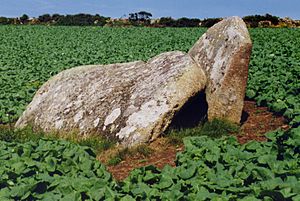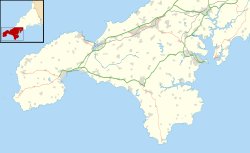West Lanyon Quoit facts for kids

Remains of West Lanyon Quoit
|
|
| Location | Cornwall |
|---|---|
| Coordinates | 50°08′52″N 5°36′28″W / 50.147703°N 5.607821°W |
| Type | Dolmen |
| History | |
| Periods | Neolithic |
West Lanyon Quoit, also called Lower Lanyon Quoit, is an ancient stone structure. It is what remains of a prehistoric dolmen, which is a type of tomb. You can find it in the area of Madron in Cornwall, England.
This old site was dug up in the late 1700s. Since then, much of its original structure has been lost or damaged.
Where to Find West Lanyon Quoit
West Lanyon Quoit is located in the southwest of England. It is northwest of a town called Penzance. The site is close to the road that connects Madron and Morvah.
You can find it about 300 meters southwest of that road. Another, more famous, stone structure called Lanyon Quoit is about 700 meters to the east.
What West Lanyon Quoit Looks Like Now
Today, only two large stones are left of West Lanyon Quoit. One stone, which probably helped hold up the tomb, is still standing. This stone is about 1.6 meters (5.2 feet) tall and 1.5 meters (4.9 feet) wide.
The other stone is a large capstone. This is the big, flat stone that would have been the roof of the tomb. It now rests against the standing stone. This capstone is quite large, measuring 4.1 meters (13.5 feet) long and 2.6 meters (8.5 feet) wide.
How West Lanyon Quoit Was Found
West Lanyon Quoit was once hidden under a large mound of earth. This type of mound is called a tumulus or barrow. The burial chamber inside was only discovered in the late 1700s.
The story of its discovery was written down in a book called Archaeologia in 1803. It explains that the landowner told his workers to dig up the earth from the mound. They wanted to use the soil as compost for their fields.
After removing "nearly a hundred cart-loads" of earth, the workers found the stone supports of a "cromlech." A cromlech is another name for a dolmen. The large cover stone had slipped off one side but was still leaning against the other stones.
The tomb chamber was shaped like a rectangle. It measured about 10 feet long, 5 feet wide, and 5 feet high. The entrance to the chamber faced northeast.
When people dug inside the chamber, they found a broken pot, some ashes, and human bones. Experts now believe that this tomb had been opened before. The pot and bones were likely from a later burial, probably from the Bronze Age. This means someone was buried there again, long after it was first built.


